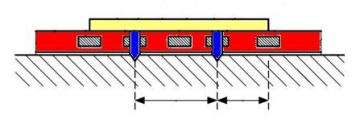February 12, 2008 weblog
Wired Wallpaper Offers Alternative to Outlets

Philips has recently designed a type of wallpaper with conducting stripes running through it, enabling electrical devices to be hooked up to just about anywhere on the wall.
Besides walls, the wallpaper could be attached to ceilings and floors as well, according to the company's recent patent application. Electrical devices would connect to the invisible wiring with contact pins, and could tap into a range of voltages, from 1 to 12 volts. The global company hopes that such a system will be ideal for future OLED devices, but could also accommodate LEDs, TVs, multimedia systems, video projectors, lamps, clocks, electroluminescent panels, and more.
Philips' conducting wallpaper is not the first of its kind, but the company hopes that its version can overcome some of the disadvantages of previous versions. Namely, Philips' wallpaper provides a range of voltages for devices, which can easily be tapped into from many positions on the wall. By repositioning the pins to correspond to specific pitches of the stripes, different voltage levels can be achieved. For safety, the system would likely have a total maximum voltage level of 50-60 volts.
The conductive stripes would be made of a metallic material such as copper, aluminum, silver, gold or steel, and receive power from an external electrical supply. The wallpaper, described as "a usual wallpaper or any kind of tapestry," would simultaneously provide electrical insulation and aesthetic value. The stripes could either be glued onto the wall and covered by the wallpaper, or the stripes could be fabricated into the wallpaper, which would then be glued to the wall as a whole sheet.
Philips also suggests a few methods for hanging the electrical devices, such as a double-sided adhesive or a mechanical connection using nails or screws. Another alternative could be a mechanical fastening involving the pins themselves.
With wired wallpaper, Philips hopes to give consumers the option of changing the positions of their electrical fixtures without needing to rewire the entire room with conventional, behind-the-wall wiring. The idea could dramatically the change the future of homes and buildings.
Conducting Wallpaper patent application via New Scientist





















